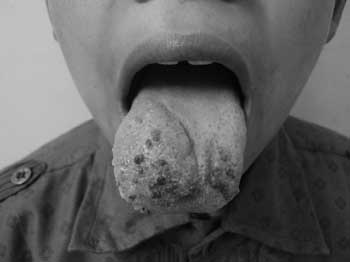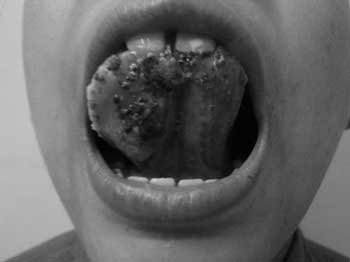|
|
|
Indian Pediatr 2012;49: 316-318
|
 |
Angiokeratoma Circumscriptum of the Tongue
|
|
Kamal Aggarwal, VK Jain, Shobhna Jangra and *Raman Wadhera
From the Department of Dermatology, Venereology and
Leperology; and *Department of ENT, Pt B D Sharma University of Health
Sciences, Rohtak, Haryana, India.
Correspondence to: Dr Kamal Aggarwal, 14/9J, Medical
Campus, Rohtak 124 001, Haryana, India.
Email:
[email protected]
Received: August 20, 2010;
Initial review: August 26, 2010;
Accepted: May 05, 2011.
|
Angiokeratoma circumscriptum is rare cutaneous disorder. It usually
presents as multiple,red, blue or black asymptomatic papules on lower
extremities. Oral involvement, common in systemic form, is rare in
localized forms. We report a case of angiokeratoma circumscriptum of
tongue, involving both dorsal and ventral aspects.
Key words: Angiokeratoma, Tongue.
|
|
Angiokeratoma is the term
applied to describe
quite distinct clinical conditions that share a
clinical presentation with asymptomatic
hyperkeratotic cutaneous vascular lesions and a histological
combination of superficial dermal vascular ectasia with overlying
hyperkeratosis. The following five varieties are generally
recognized: (i) generalized systemic type angiokeratoma
corporis diffusum of Fabry; (ii) Bilateral form occurring on
the dorsa of fingers and toes- angiokeratoma of Mibelli; (iii)
Localized scrotal form-angiokeratoma of Fordyce; (iv)
Solitary papular angiokeratoma and (v) Multiple papular and
plaque like -angiokeratoma circumscriptum [1]. All types, though
differ clinically, share the same histological features, i.e.
hyperkeratosis, acanthosis and dilated capillaries in the papillary
dermis that are partly or completely enclosed by the papillomatous
epidermis. Angiokeratoma circumscriptum presents as multiple purple
papules that later become verrucous plaques. We report a case of 10
year old male, who presented with lesions of angiokeratoma
circumscriptum, extending onto both the dorsal and ventral surfaces
of tongue.
Case Report
A 10 year old boy presented with multiple, red
small raised lesions on the tongue for the last 4 years. The
condition started as an asymptomatic single raised lesion on the
undersurface of the tongue which gradually increased in number and
extended onto the sides and upper surface of the tongue. There was
no preceeding history of trauma or bleeding from lesions. Patient
denied any history of similar lesions elsewhere on the body. His
past medical history was unremarkable.
 |
 |
|
Fig.1 Raised lesions of
angiokeratoma circumscriptum on the (a) dorsum of the tongue
and (b) extending onto the ventral
surface of the tongue.
|
On examination of the oral cavity, the patient
was found to have two raised lesions of sizes 1×1cm and 2×3 cm, on
the dorsum of the tongue, anterior to the base, which were extending
onto the ventral surface of the tongue. They were studded with
multiple grouped, erythematous shining papules some of which had a
keratotic top. The masses were non-friable and moderately tender on
palpation. They were mobile, firm on palpation, and did not bleed on
manipulation. The rest of the cutaneous and systemic examination was
normal. A biopsy specimen of a representative tongue lesion showed
parakeratosis, acanthosis, papillomatosis with large dilated spaces
lined by normal appearing endothelium and filled with erythrocytes
and organizing thrombi. On the basis of clinical examination and
histopathological findings, a diagnosis of angiokeratoma
circumscriptum of the tongue was made.
Discussion
Angiokeratoma circumscriptum is a rare vascular
malformation of the papillary dermis manifesting as one or several
purple papules and blood filled cystic nodules that gradually become
verrucous and coalese into plaques. They may be linear or
zosteriform pattern and bleed readily from trauma. Vessels are
ectatic histologically and may be thrombosed. The overlying
epidermis shows variable degree of hyperkeratosis, papillomatosis
and acanthosis. The elongated rete ridges may partially or
completely envelop the dilated vessels. Usually, the lesions are
present at birth, but in some cases they may occur during childhood
as in our case and even in adulthood. Angiokeratoma may be
associated with Klippel-Trenaunay, Weber syndrome, Cobb syndrome and
other mixed vascular malformations. The lesions are typically
situated on the lower leg, foot, thigh or buttock but may occur
elsewhere on the skin [5,6].
Oral involvement in angiokeratomas is most
commonly a component of angiokeratoma corporis diffusum which is
associated with several inherited lysosomal disorders [6] It is rare
in other types of angiokeratomas.
Till date there are three reported cases of
angiokeratoma circumscriptum solely localized to the oral cavity in
pediatric patients [2-4]. Kumar, et al. reported the case of
a 16 year old boy with histologically defined angiokeratoma
circumscriptum on the ventral aspect of the tongue [3]. Another 12
year old boy with angiokeratoma circumscriptum isolated to the
ventral tongue was reported [2]. The third patient was a 6-year old
male who presented with a 2 year history of recurrent mass on the
dorsal tongue [4]. Our case of lingual angiokeratoma circumscriptum
involved both the dorsal and ventral surfaces of the tongue. Another
interesting point to be noted is that all four patients including
ours were male patients.
The pathogenesis of angiokeratomas is still
unknown. It has been reported to develop overlying an arteriovenous
fistula and in areas of lymphangioma circumscriptum after local
injuries [7,8]. Angikeratomas may be treated with complete surgical
excision, cryotherapy and laser ablation including copper vapour,
potassium tritanyl phosphate, and argon lasers.
Contributors: All the authors have
participated equally in the preparation of the article.
Funding: None; Competing interests:
None stated.
References
1. Leung CS, Jordan RCK. Solitary angiokeratoma
of the oral cavity. Oral Surg Oral Med Oral Path. Oral Radiol Endod.
1997;84:51-3.
2. Vijaikumar M, Thappa DM, Karthikeyan K,
Jayanthi S. Angiokeratoma circumscriptum of the tongue. Pediatr
Dermatol. 2003;20:180-2.
3. Kumar MV, Thappa DM, Shanmugam, Ratnakar C.
Angiokeratoma circumscriptum of the oral cavity. Acta Derm Venereol.
1998;78:472.
4. Green JB, Roy S. Angiokeratoma circumscriptum
of the dorsal tongue in a child. Int J Pediatr Dermatol.
2006;1:107-9.
5. Calonje E, Wilson-Jones E. Vascular tumors.
In: Elder D, Elenitsas R, Jaworsky C, Joohnson B Jr., eds.
Lever’s Histopathology of the Skin. Philadelphia: Lippincott-Raven;
1997.
6. Atherton DJ. Naevi and other developmental
defects. In: Champion RH, Burton JL, Burns DA, Breathnach SM,
eds. Rook’s Textbook of Dermatology. Oxford: Blackwell Scientific
Publication; 1998.
7. Foucar W, Nason WV. Angiokeratoma
circumscriptum following damage to underlying vasculature. Arch
Dermatol. 1986;122:245-6.
8. Kim JH, Nam TS, Kim SH. Solitary angiokeratoma
developed in one area of lymphangioma circumscriptum. J Korean Med
Sci 1988;3:169-70.
|
|
|
 |
|

